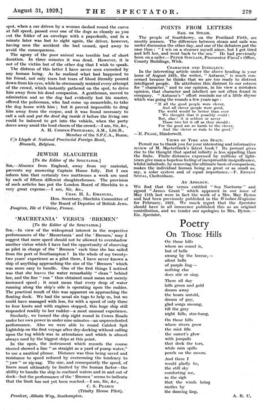MAURETANIA ' VERSUS 'BREMEN' [To the Editor of the SPEcrivron.]
SIR,—In view of the widespread interest in the respective performances of the ' Mauretania' and the Bremen,' may I suggest that mere speed should not be allowed to overshadow another virtue which I have had the opportunity of observing as pilot in charge of the 'Bremen' each time she has sailed from the port of Southampton ? In the whole of my twenty- two years' experience as a pilot there, I have never known a ship of anything approaching the size of the 'Bremen' which was more easy to handle. One of the first things I noticed was that she leaves the water remarkably " clean " behind her, and the fine " run " thus obtained must mean not merely increased speed ; it must mean that every drop of water running along the ship's side is operating upon the rudder. The practical result of this was apparent on approaching the floating dock. We had the usual six tugs to help us, but we could have managed with less, for with a speed of only three to four knots and with engines stopped, this huge ship still responded readily to her rudder—a most unusual experience.
Similarly, we turned the ship right round in Cowes Roads under her own power in under nine minutes—an unprecedented performance. Also we were able to round Calshot Spit Lightship on the first voyage after dry-docking without calling upon the tug which was in attendance and which is almost always used by the biggest ships at this point.
In the open, the instrument which records the course steered showed a line "as straight as a yard of pump water," to use a nautical phrase. Distance was thus being saved and resistance to speed reduced by overcoming the tendency to " yaw " or zig-zag. The size, and consequently the speed, of liners must ultimately be limited by the human factor—the 'ability to handle the ship in confined waters and in and out of dock—but the performance of the 'Bremen' seems to indicate that the limit has not yet been reached.—! am, Sir, &c., C. S. PEARCE
































 Previous page
Previous page